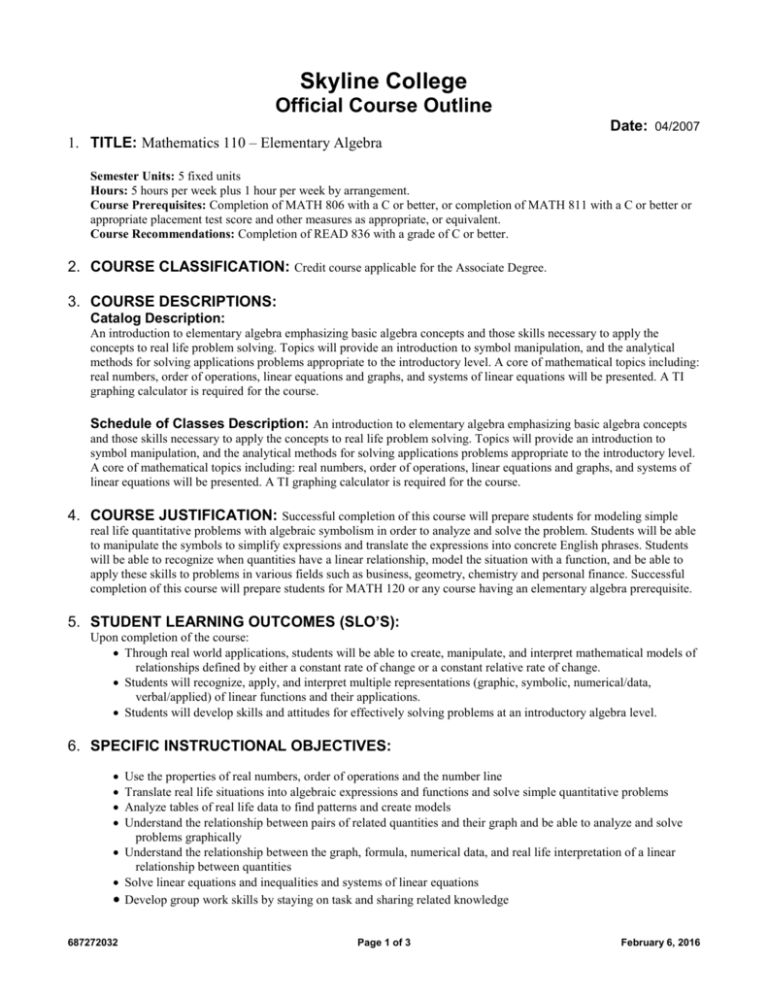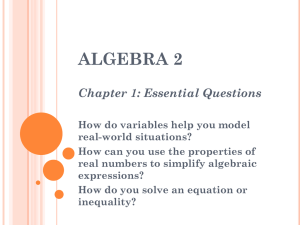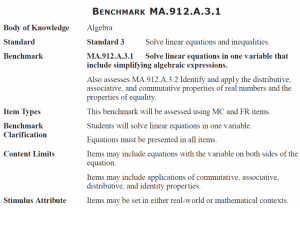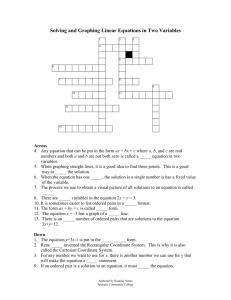
Skyline College
Official Course Outline
Date: 04/2007
1. TITLE: Mathematics 110 – Elementary Algebra
Semester Units: 5 fixed units
Hours: 5 hours per week plus 1 hour per week by arrangement.
Course Prerequisites: Completion of MATH 806 with a C or better, or completion of MATH 811 with a C or better or
appropriate placement test score and other measures as appropriate, or equivalent.
Course Recommendations: Completion of READ 836 with a grade of C or better.
2. COURSE CLASSIFICATION: Credit course applicable for the Associate Degree.
3. COURSE DESCRIPTIONS:
Catalog Description:
An introduction to elementary algebra emphasizing basic algebra concepts and those skills necessary to apply the
concepts to real life problem solving. Topics will provide an introduction to symbol manipulation, and the analytical
methods for solving applications problems appropriate to the introductory level. A core of mathematical topics including:
real numbers, order of operations, linear equations and graphs, and systems of linear equations will be presented. A TI
graphing calculator is required for the course.
Schedule of Classes Description: An introduction to elementary algebra emphasizing basic algebra concepts
and those skills necessary to apply the concepts to real life problem solving. Topics will provide an introduction to
symbol manipulation, and the analytical methods for solving applications problems appropriate to the introductory level.
A core of mathematical topics including: real numbers, order of operations, linear equations and graphs, and systems of
linear equations will be presented. A TI graphing calculator is required for the course.
4. COURSE JUSTIFICATION: Successful completion of this course will prepare students for modeling simple
real life quantitative problems with algebraic symbolism in order to analyze and solve the problem. Students will be able
to manipulate the symbols to simplify expressions and translate the expressions into concrete English phrases. Students
will be able to recognize when quantities have a linear relationship, model the situation with a function, and be able to
apply these skills to problems in various fields such as business, geometry, chemistry and personal finance. Successful
completion of this course will prepare students for MATH 120 or any course having an elementary algebra prerequisite.
5. STUDENT LEARNING OUTCOMES (SLO’S):
Upon completion of the course:
Through real world applications, students will be able to create, manipulate, and interpret mathematical models of
relationships defined by either a constant rate of change or a constant relative rate of change.
Students will recognize, apply, and interpret multiple representations (graphic, symbolic, numerical/data,
verbal/applied) of linear functions and their applications.
Students will develop skills and attitudes for effectively solving problems at an introductory algebra level.
6. SPECIFIC INSTRUCTIONAL OBJECTIVES:
Use the properties of real numbers, order of operations and the number line
Translate real life situations into algebraic expressions and functions and solve simple quantitative problems
Analyze tables of real life data to find patterns and create models
Understand the relationship between pairs of related quantities and their graph and be able to analyze and solve
problems graphically
Understand the relationship between the graph, formula, numerical data, and real life interpretation of a linear
relationship between quantities
Solve linear equations and inequalities and systems of linear equations
Develop group work skills by staying on task and sharing related knowledge
687272032
Page 1 of 3
February 6, 2016
7. COURSE CONTENT:
A. Real Numbers
Use a graphing calculator to evaluate numerical and algebraic expressions, and use a graph and tables to
estimate extreme values, domain and range, and points of intersection of two graphs
Define real numbers and its subsets, opposite, absolute value, square root, base and exponent
Graph numbers on a number line and use the graph to compare two numbers
Translate English phrases into numerical and algebraic expressions
Apply order of operations to evaluate a numerical expression
State and use the properties of real numbers
B. Algebraic Expressions
Define numerical expressions, algebraic expression, equation, formula, term, like terms, coefficient, the
components of a Cartesian coordinate system, relation, function, domain, range, extreme values, and intercepts
Evaluate algebraic expressions and functions algebraically and using graphing calculators (y-screen, home
screen, table, trace, value)
Use pythagorean theorem, distance formula, mid-point formula to solve related problems
C. Introduction to Functions
Graph ordered pairs and relations on a Cartesian coordinate system
Recognize functions from a formula and graph and state the domain and range
Solve related applications
D. Linear Equations
Define linear equation in one variable, linear inequality, solution and solution set, identity, inconsistent and
conditional
Solve linear equations, formulas, and linear inequalities algebraically and using graphing calculators
Solve related application and modeling problems
E. Linear Functions
Define slope, standard, slope-intercept, and point-slope form of a linear equation
Find and verify ordered pair solutions to linear equations in two variables
Sketch the graph of a line given two points, a point and the slope, or given the equation
Find the equation of a line given the graph, two ordered pairs, or a point and the slope
Be able to find the equation of a line parallel or perpendicular to a given line given one ordered pair
Determine the intercepts of a line
Model linear data with linear functions
Model almost linear data with linear functions
Interpret constant rate of change in various situations
Solve problems that can be modeled by linear functions
F. Linear Systems of Equations
Define the terms system of equations, dependent and independent, solution to a system, ordered triple
Solve systems using the graphing, addition, and substitution methods
Solve problems that can be modeled with a system of equations
687272032
Page 2 of 3
February 6, 2016
8.
REPRESENTATIVE METHODS OF INSTRUCTION: The course will be taught with a
lecture/discussion format with an emphasis in collaborative learning. Technology may be used to support core
classroom instruction. Students will be assigned reading and problems to solve. Students are expected to
average two hours of outside work for each hour of class instruction. They are also required to use a graphing
calculator to solve problems involving multiple calculation steps.
Beyond normal reading skills are required to comprehend extensive mathematical symbolism and interpret
detailed sketches and diagrams. Students are also expected to be able to provide written explanations and
descriptions of graphical representations
Students are required to analyze problems, determine appropriate methods, set up diagrams, execute
calculations, and correctly interpret numerical answers. Work of this type will be done during class time and as
part of outside classroom assignments. Students are expected to average two hours of outside work for each
hour of class instruction.
Critical thinking skills are necessary to correctly analyze problems, model problems, set up appropriate
diagrams and graphs, and correctly interpret results.
9. ASSIGNMENTS: Students will be required to spend out of class time practicing math skills. These out of
class assignments may include homework problems, take-home quizzes, use the mathematics from the class in
projects such as finding data sets and modeling the data with an appropriate function and solving problems
based on the model and writing a short report on the connections, and web-based problems.
10. EVALUATION OF STUDENT PERFORMANCE: Students will be evaluated on the basis of
regular examinations and a comprehensive final examination. (At the option of the instructor, homework and
quizzes may also be part of the evaluation.) Letter graded. Students will be evaluated on their ability to analyze
problems, determine appropriate methods, set up diagrams, execute calculations, and correctly interpret
numerical answers. Work of this type will be done during class time and as part of outside classroom
assignments. Critical thinking skills are necessary to correctly analyze problems, model problems, draw
appropriate diagrams and graphs, and correctly interpret results.
11. RECOMMENDED or REQUIRED TEXT(S): Example of an acceptable text: Elementary
and Algebra, Graphs & Authentic Applications, Jay Lehmann; Pearson/Prentice Hall, 2008
687272032
Page 3 of 3
February 6, 2016











